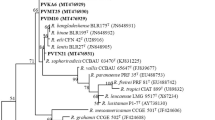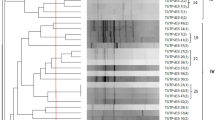Abstract
Common bean (Phaseolus vulgaris L.) is a legume that has been reported as highly promiscuous in nodulating with a variety of rhizobial strains, often with low effectiveness in fixing nitrogen. The aim of this work was to assess the symbiotic efficiency of rhizobial strains isolated from common bean seeds, nodules of Arachis hypogaea, Mucuna pruriens, and soils from various Brazilian agroecosystems, followed by the characterization of elite strains identified in the first screening. Forty-five elite strains were analyzed for symbiotic properties (nodulation, plant-growth, and nitrogen-fixation parameters) under greenhouse conditions in pots containing non-sterile soil, and variation in symbiotic performance was observed. Elite strains were also characterized in relation to morpho-physiological properties, genetic profiles of rep-polymerase chain reaction (PCR; BOX), and restriction fragment length polymorphism (RFLP)-PCR of the 16S rRNA. Sequence analyses of the 16S rRNA were obtained for 17 strains representative of the main groups resulting from all previous analyses. One of the most effective strains, IPR-Pv 2604, was clustered with Rhizobium tropici, whereas strain IPR-Pv 583, showing lower effectiveness in fixing N2, was clustered with Herbaspirillum lusitanum. Surprisingly, effective strains were clustered with unusual symbiotic genera/species, including Leifsonia xyli, Stenotrophomonas maltophilia, Burkholderia, and Enterobacter. Some strains recognized in this study were outstanding in their nitrogen-fixing capacity and therefore, show high biotechnological potential for use in commercial inoculants.






Similar content being viewed by others
References
Aguilar OM, López MV, Riccillo PM, González RA, Pagano M, Grasso DH, Pühler A, Favelukes G (1998) Prevalence of the Rhizobium etli-like allele in genes coding for 16S rRNA among the indigenous rhizobial populations found associated with wild beans from the Southern Andes in Argentina. Appl Environ Microbiol 64:2524–3520
Andrade DS, Hamakawa PJ (1994) Estimativa do número de células viáveis de rizóbio no solo e em inoculantes por infecção em plantas. Manual de métodos empregados em estudos de microbiologia agricula EMBRAPA-SPI:63–94
Andrade DS, Murphy PJ, Giller KE (2002) The diversity of Phaseolus-nodulation rhizobial populations is altered by liming of acid soils planted with Plaseolus vulgaris L. in Brazil. Appl Environ Microbiol 68(8):4025–4034
Baldani JI, Baldani VLD, Seldin L, Döbereiner J (1986) Characterization of Herbaspirillum seropedicae gen. nov.: a root-associated nitrogen-fixing bacterium. Int J Syst Bacteriol 36:86–93
Binde DR, Menna P, Bangel EV, Barcellos FG, Hungria M (2009) rep-PCR fingerprinting and taxonomy based on the sequencing of the 16S rRNA gene of 54 elite commercial rhizobial strains. Appl Microbiol Biotechnol 83:897–908
Bremner J, Keeney D (1966) Steam distillation methods for determination of ammonium, nitrate and nitrite. Anal Chem Acta 32:482–485
Brockwell J, Hely FW, Neal-Smith CA (1966) Some symbiotic characteristics of rhizobia responsible for spontaneous, effective field nodulation of Lotus hispidus. Austr J Exp Agric Anim Husband 6:365–370
Caballero-Mellado J, Martinez-Romero E (1999) Soil fertilization limits the genetic diversity of Rhizobium in bean nodules. Symbiosis 26:111–121
Cubo T, Romero F, Vinardell JM, Ruiz-Sainz JE (1997) Expression of the Rhizobium leguminosarum biovar phaseoli melA gene in other rhizobia does not require the presence of the nifA gene. Aust J Plant Physiol 24:195–203
Denton M, Kerr KG (1998) Microbiological and clinical aspects of infection associated with Stenotrophomonas maltophilia. Clin Microbiol Rev 11:57–80
Dôbereiner J (1992) History and new perspectives of diazotrophs in association with non-leguminous plants. Symbiosis 13:1–13
Ewing B, Green P (1998) Base-calling of automated sequencer traces using phred. II. Error probabilities. Genome Res 8:186–194
Ewing B, Hillier L, Wendl MC, Green P (1998) Base-calling of automated sequencer traces using phred. I. Accuracy assessment. Genome Res 8:175–185
Fages J, Arsac JF (1991) Sunflower inoculation with Azospirillum and other plant growth promoting rhizobacteria. Plant Soil 137:87–90
Felsenstein J (1985) Confidence limits on phylogenies: an approach using the bootstrap. Evolution 39:783–791
Gagliardi PR, Camargo LEA (2009) Resistência de variedades comerciais de cana-de-açúcar ao agente causal do raquitismo-da-soqueira. Cienc Rural 39:1211–1214
Geng J, Yuan P, Shao C, Yu S-B, Zhou BZ, Chen X-D (2010) Bacterial melanin interacts with double-stranded DNA with high affinity and may inhibit cell metabolism in vivo. Arch Microbiol 192:321–329
Giongo A, Passaglia LMP, Freire JRJ, de Sá ELS (2007) Genetic diversity and symbiotic efficiency of population of rhizobia of Phaseolus vulgaris L. in Brazil. Biol Fert Soils 43:593–598
Gordon D, Abajian C, Green P (1998) Consed: a graphical tool for sequence finishing. Genome Res 8:195–202
Graham PH (1981) Some problems of nodulation and symbiotic nitrogen fixation in Phaseolus vulgaris: a review. Field Crops Res 4:93–112
Grange L, Hungria M (2004) Genetic diversity of indigenous common bean (Phaseolus vulgaris) rhizobia in two Brazilian ecosystems. Soil Biol Biochem 36:1389–1398
Grange L, Hungria M, Graham PH, Martínez-Romero E (2007) New insights into the origins and evolution of rhizobia that nodulate common bean (Phaseolus vulgaris) in Brazil. Soil Biol Biochem 39(4):867–876
Hauben L, Vauterin L, Moore ERB, Hoste B, Swings J (1999) Genomic diversity of the genus Stenotrophomonas. Int J Syst Bacteriol 49:1749–1760
Hedges SB (1992) The number of replications needed for accurate estimation of the bootstrap p-value in phylogenetic studies. Mol Biol Evol 9:366–369
Herridge DF, Peoples MB (1990) Ureide assay for measuring nitrogen fixation by nodulated soybean calibrated by N methods. Plant Physiol 93:495–503
Herridge DF, Bergersen FJ, Peoples MB (1990) Measurement of nitrogen fixation by soybean in the field using the ureide and natural N abundance methods. Plant Physiol 93:708–716
Hungria M, Vargas MAT (2000) Environmental factors affecting N2 fixation in grain legumes in the tropics, with an emphasis on Brazil. Field Crops Res 65:151–164
Hungria M, Andrade DS, Chueire LMDO, Probanza A, Guttierrez-Mañero FJ, Megías M (2000) Isolation and characterization of new efficient and competitive bean (Phaseolus vulgaris L.) rhizobia from Brazil. Soil Biol Biochem 32(11–12):1515–1528
Hungria M, Campo RJ, Mendes IC (2003) Benefits of inoculation of the common bean (Phaseolus vulgaris) crop with efficient and competitive Rhizobium tropici strains. Biol Fert Soils 39(2):88–93
James EK (2000) Nitrogen fixation in endophytic and associative symbiosis. Field Crop Res 65(2–3):197–209
Jordan DC (1984) Family III. Rhizobiaceae Conn 1938. In: Krieg NR, Holt JG (eds) Bergey’s manual of systematic bacteriology. Williams and Wilkins, Baltimore-London, pp 235–244
Kaschuk G, Hungria M, Andrade DS, Campo RJ (2006) Genetic diversity of rhizobia associated with common bean (Phaseolus vulgaris L.) grown under no-tillage and conventional systems in Southern Brazil. Appl Soil Ecol 32(2):210–220
Kumar S, Tamura K, Nei M (2004) MEGA3: integrated software for molecular evolutionary genetics analysis and sequence alignment. Brief Bioinform 5:150–163
Laguerre G, Allard MR, Revoy F, Amarger N (1994) Rapid identification of rhizobia by restriction fragment length polymorphism analysis of PCR-amplified 16S rRNA genes. Appl Environ Microbiol 60:56–63
Martinez-Romero E, Segovia E, Mercante FM, Franco AA, Graham PH, Pardo MA (1991) Rhizobium tropici, a novel species nodulating Phaseolus vulgaris L. beans and Leucaena sp. trees. Int J Syst Bacterial 41:417–426
Mehnaz S, Kowalik T, Reynolds B, Lazarovits G (2010) Growth promoting effects of corn (Zea mays) bacterial isolates under greenhouse and field conditions. Soil Biol Biochem 42(10):1848–1856
Menna P, Hungria M, Barcellos FG, Bangel EV, Hess PN, Martínez-Romero E (2006) Molecular phylogeny based on the 16S rRNA gene of elite rhizobial strains used in Brazilian commercial inoculants. Syst Appl Microbiol 29(4):315–332
Michiels J, Dombrecht B, Vermeiren N, Xi C, Luyten E, Vanderleyden J (1998) Phaseolus vulgaris is a non-selective host for nodulation. FEMS Microbiol Ecol 26:193–205
Miyazawa M, Pavan MA, Block MF (1985) Spectrophotometry determination of nitrate in soil extracts without chemical reduction. Pesq Agropec Bras 20:129–133
Moawad H, El-Din B, Abdel-Aziz RA (1998) Improvement of biological nitrogen fixation in Egyptian winter legumes through better management of Rhizobium. Plant Soil 204:95–106
Mostasso L, Mostasso FL, Dias BG, Vargas MAT, Hungria M (2002) Selection of bean (Phaseolus vulgaris L.) rhizobial strains for the Brazilian cerrados. Field Crop Res 73:121–132
Pavan MA, Bloch MFD, Zempulski HCD, Miyazawa M, Zocoler DC (1992) Manual de análise quimica de solo e controle de qualidade. Instituto Agronomico do Paraná, Londrina
Reinhardt ÉL, Ramos PL, Manfio GP, Barbosa HR, Pavan C, Moreira-Filho CA (2008) Molecular characterization of nitrogen-fixing bacteria isolated from Brazilian agricultural plants at São Paulo state. Braz J Microbiol 39:414–422
Saitou N, Nei M (1987) The neighbor-joining method: a new method for reconstructing phylogenetic trees. Mol Biol Evol 4:406–425
SAS I (1999) SAS/STAT user’s guide. SAS Institute Inc 12: Cary
Sneath PHA, Sokal RR (1973) Numerical taxonomy. W H Freeman, San Francisco
Stocco P, Santos JCPd, Vargas VP, Hungria M (2008) Avaliação da biodiversidade de rizóbios simbiontes do feijoeiro (Phaseolus vulgaris L.) em Santa Catarina. Rev Bras Cienc Solo (32):1107–1120
Teixeira MA, Melo ISd, Vieira RF, Costa FEC, Harakava R (2007) Microrganismos endofíticos de mandioca de áreas comerciais e etnovariedades em três estados brasileiros. Pesq Agropec Bras 42:42–49
Thompson JD, Gibson TJ, Plewniak F, Jeanmougin F, Higgins DG (1997) The clustal X windows interface: flexible strategies for multiple sequence alignment aided by quality analysis tools. Nucleic Acids Res 25:4876–7882
Valverde A, Velázquez E, Gutiérrez C, Cervantes E, Ventosa A, Igual JM (2003) Herbaspirillum lusitanum sp. nov., a novel nitrogen-fixing bacterium associated with root nodules of Phaseolus vulgaris. Int J Syst Evol Microbiol 53:1979–1983
Versalovic J, Schneider M, de Bruijn FJ, Lupski JR (1994) Genomic fingerprinting of bacteria using repetitive sequence-based polymerase chain reaction. Method Mol Cell Biol 5:25–40
Vincent JM (1970) A manual for the practical study of root-nodule bacteria. Blackwell Scientific, Oxford, IBP handbook, 15
Weisburg WG, Barns SM, Pelletier DA, Lane DJ (1991) 16S ribosomal DNA amplification for phylogenetic study. J Bacteriol 173:697–703
Acknowledgments
The first author thanks Capes (Coordenação de Aperfeiçoamento de Pessoal de Nível Superior) for the PhD scholarship. The authors are grateful to Walter M. Kranz for help with the soil sampling. Authors also thank Maria Elisabeth Vasconcellos (IAPAR) for help with the multivariate analyses and L.F.A. Fregonesi to organize the map, to Mauro S Parra (IAPAR) for helping with the greenhouse experiment, and Dr. Allan R. J. Eaglesham for suggestions on the manuscript. The research was partially supported by CNPq (Conselho Nacional de Desenvolvimento Científico e Tecnológico)/MCT/MAPA (577933/2008) and CNPq-Repensa (562008/2010-1). M. Hungria also acknowledges a research fellowship from CNPq (300547/2010-2).
Author information
Authors and Affiliations
Corresponding author
Rights and permissions
About this article
Cite this article
Cardoso, J.D., Hungria, M. & Andrade, D.S. Polyphasic approach for the characterization of rhizobial symbionts effective in fixing N2 with common bean (Phaseolus vulgaris L.). Appl Microbiol Biotechnol 93, 2035–2049 (2012). https://doi.org/10.1007/s00253-011-3708-2
Received:
Revised:
Accepted:
Published:
Issue Date:
DOI: https://doi.org/10.1007/s00253-011-3708-2




